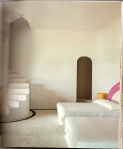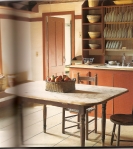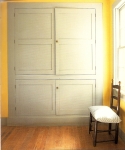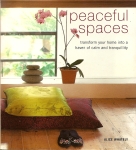The cart before the horse is neither beautiful nor useful. Before we can adorn our houses with beautiful objects the walls must be stripped, and our lives must be stripped, and beautiful housekeeping and beautiful living be laid for a foundation…” –Henry David Thoreau
I think there are about three blog entries that the above quote can be a springboard for, but let me start with a little visual inspiration.
“…the walls must be stripped…”
One of my favorite books is Peaceful Spaces by Alice Whately. The pictures above are all from this book. I keep it out on one of my living room tables. Every picture in it is inspiration for serenity and simplicity in the environment of the home. Sometimes it’s hard to tear myself away from the picture to read the advice:
On Space Clearing: “By questioning the purpose of everything you own, you will quickly realize that it is you, rather than the stuff that surrounds you, that must take center stage in the home.”
On Balance and Form: “To achieve harmony in the home, it is vital to create a balance between form and function. This concept derives from the Zen aesthetic of yin and yang, or in layman’s terms, opposing forces which, when equally represented, create a harmonious balance of energy.”
On Living Spaces: “Opting for an uncontrived palette allows for the display of different furnishing styles and for the introduction of pattern and discreet touches of luxury.”
On Sleeping: “Keep your sleeping space simple. Reduce furniture to the bare minimum, adopt a cohesive color scheme and rely on space, light, and texture to create a sensory haven.”
On Eating: “As long as your eating and cooking space remains warm and clutter-free, it is possible to create a feeling of wellbeing through the creation of two very different styles. If you’re the efficient type, the clean-cut minimalist look is best. If you’re earthier and more relaxed, the modern rustic look is likely to be more appropriate.”
The stripping-down theme that Thoreau suggested long ago is put into practical terms by Alice Whately. My husband and I recently refinished our living room floors. Actually, “living room” in our house is a misnomer. Like most people whose homes were built in the 70s and 80s, our “living” is done everywhere in the house BUT the living room. We spend most of our time in the family room. Now, of course, the newer homes have evolved the concept of living rooms and family rooms into “great rooms” where the living spaces include the kitchen.
Yet, I really love this particular room, which I’ll simply call my “living quietly room” because rather than making it a museum-like space for the occasional visitor, I use it as a creative space. There are bookshelves in it, and a piano, and parsons chairs by the windows where I can sit in the light and look out on the world, and a table for writing, or eating or sharing tea with a friend.
The point is, to refinish the floors we had to remove all the furniture. At the same time we decided to paint the walls, so we took down all the pictures and window treatments.
When it came time to put the stuff back, I made a conscious decision to put back ONLY what was necessary, rather than try to find a place for all the stuff that I had–which was a paradigm shift for me. It made all the difference in how I feel when I’m in that room, surrounded only by things that have a purpose, whether functional, or aesthetic, or both.
The other thing that made a big difference was simply in the literal stripping down of the floor and the repainting of the walls. When the foundation is clean and pristine, you don’t need to cover up flaws with stuff. Before my floors were refinished, I had them covered up with inexpensive rugs. But once they were gleaming, I was able to eliminate the rugs. So, Thoreau’s admonition to strip the walls should be taken literally, if beauty is to be found within.
When rooms are suited to our spirits, they become our temples. I, for one, prefer a simple chapel such as the one I frequently visit up at the Weston Priory in Vermont, with its neutral walls, flagstone floors, bare altar, and long windows from which you can watch the sun rise over their pond during matins at daybreak.
Those elements of bringing the outside in and creating a space for the soul can be adapted by anyone–you don’t need to live in a monastery. As Pablo Picasso famously said, “Art is the elimination of the unnecessary.” So, all you really have to do is start eliminating.
.




What a lovely blog you have. I’ve really enjoyed your thoughts, your writing, and how you’ve woven it together with the photos and illustrations.
Your before and after pix of your dining room table sure depict the transformation from chaos to tranquility.
I look forward to reading more of your essays…
Thank you so much! So nice of you to leave this comment!
Love the quotes and how you shared your process. Keeping only the purposeful items in a room is a great way to “suit it to your spirit.” Well said.
Great read, loved every word of it! Thanks for sharing 🙂
Ooh, I have some flagstone. You’re making me want to use it in the bathroom. That would be fabulous! Great post, Catherine.